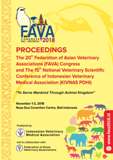PF-30 Anatomical Characteristic of Hindlimb Skeleton of Sumatran Rhino (Dicerorhinus sumatrensis)
Abstract
Sumatran rhino (Dicerorhinus sumatrensis) is an endangered animal in Indonesia. Currently, Sumatran rhino only found on Sumatera and Kalimantan in very small populations. These herbivorous animals are classified into the order of Perissodactyla (odd-toed animals) and family Rhinocerotidae [1]. Sumatran rhino is one of the largest living land mammals, reaching 1000 kg [1], although this species has the smallest body weight among all extant rhinos. This animal has a round and long body shape, relatively short legs with three digits on each leg. These body structures correspond to their habitat in the highlands, so the Sumatran rhino has an excellent ability to pass steep terrain [2]. For this reason, a strong hind limb structure is needed to push the body when walking, running and climbing the steep slopes. Therefore, this study was carried out in order to analyze the correlation between the Sumatran rhino’s hind limb skeleton and its functional roles.

